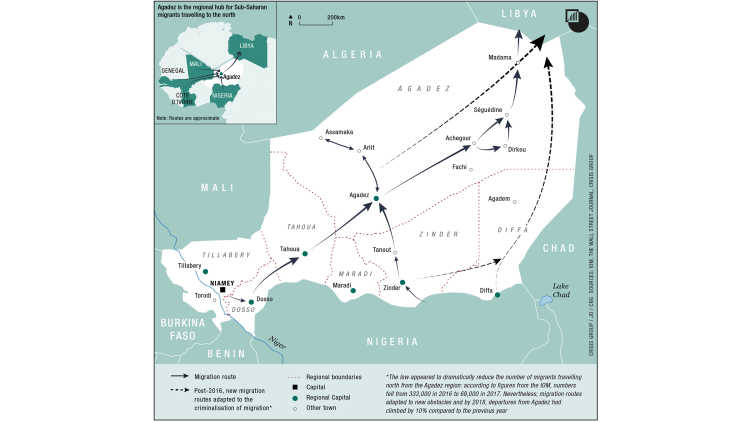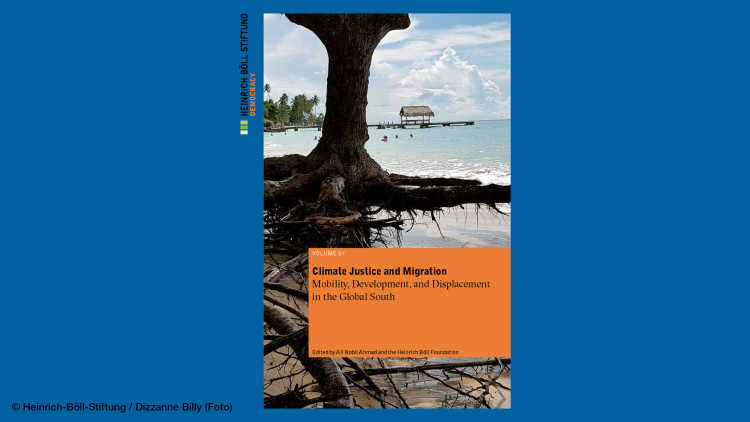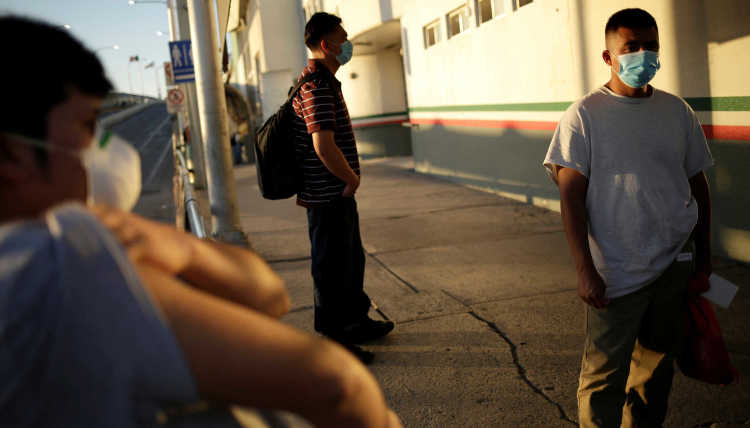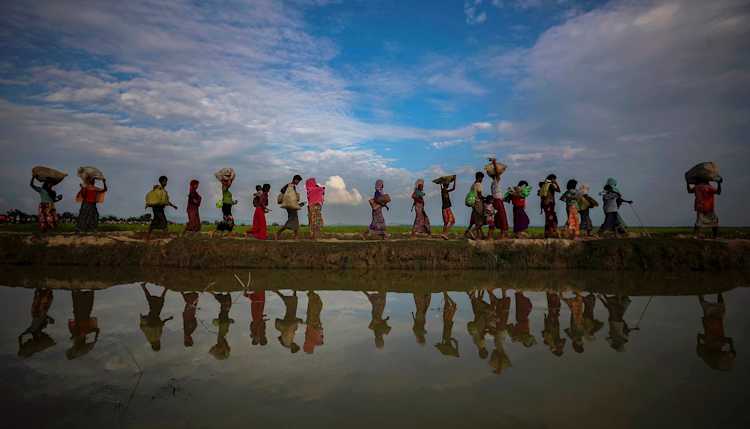- Startseite
- Publikationen
- GIGA Focus
- How EU Pressure Hampers Circular Migration between Niger and Libya
GIGA Focus Nahost
Druck der EU beeinträchtigt zirkuläre Migration zwischen Niger und Libyen
Nummer 5 | 2021 | ISSN: 1862-3611

Unter dem Druck europäischer Partner erließ die nigrische Regierung am 26. Mai 2015 das Gesetz 36-2015. Darin wird der Bevölkerung verboten, internationale Migrantinnen und Migranten von Agadez nach Norden in Richtung Libyen oder Algerien zu befördern. Vermeintlich zielt dieses Gesetz lediglich auf internationale Migration. Eine genauere Analyse zeigt allerdings auf weitreichende Auswirkungen auf zirkuläre Migration und die lokale Bevölkerung.
Die Umsetzung des Gesetzes 36-2015 hat sich negativ auf die lokale Ökonomie in der Region Agadez ausgewirkt, da ein Großteil der Bevölkerung, der bis dahin von Migration im weiteren Sinne gelebt hat, plötzlich arbeitslos wurde.
Als Reaktion auf die Umsetzung des Gesetzes haben Transportunternehmen sowie Migrantinnen und Migranten verschiedene Strategien entwickelt, um die neuen Restriktionen zu umgehen. Infolgedessen ist Migration nach Libyen und Algerien teurer und gefährlicher geworden. Transportunternehmen sind nun gezwungen, inoffizielle Routen zu nutzen, für die örtliche Sicherheitsbeamte höhere Bestechungsgelder einfordern.
Da Migrationsrouten klandestiner, gefährlicher und teurer geworden sind, ist die offizielle Anzahl von Nigrerinnen und Nigrern, die nach Libyen oder Algerien auswandern, zurückgegangen. Dies hat unbeabsichtigte Folgen für die lokale Bevölkerung, für welche das Einkommen aus verschiedenen Formen von Migration ein wichtiger Teil der eigenen Resilienzstrategie ist, um Arbeitslosigkeit, Armut und Dürre entgegenzuwirken.
Da sich das Gesetz ausschließlich auf internationale Migrantinnen und Migranten bezieht, haben internationale NGOs in der Region Agadez damit begonnen, ihre Arbeit hauptsächlich auf nicht nigrische Migrantinnen und Migranten zu konzentrieren. Als Folge entsteht Unzufriedenheit in der lokalen Bevölkerung mit dem Potenzial für künftige Gewalt.
Fazit
Die Europäische Union darf humanitäre Hilfe nicht länger als Druckmittel zur Durchsetzung europäischer Externalisierungspolitik einsetzen. Anstatt eine Migrationspolitik in Subsahara-Afrika zu verfolgen, die negative Folgen für traditionelle und lokale Formen von Migration verursacht, sollten politische Entscheidungsträgerinnen und -träger Vorschläge erarbeiten, die das Wissen, die Perspektiven und die Bedürfnisse sowohl lokaler Organisationen als auch der betroffenen lokalen Bevölkerung – Migrantinnen und Migranten sowie Nichtmigrantinnen und -migranten, ohne Diskriminierung – berücksichtigen.
Nigerien Migration to Libya
Libya is one of the most import immigration countries in Africa and has continued to be so despite the conflicts and violence of the past decade. While Libya is mainly perceived as a place of departure to Europe – or, in recent years, as a country of transit – Libya has historically mostly been a destination country for temporary labour migration, especially from Arab and sub-Saharan African countries. Migration from Niger to Libya falls into this category. Nigeriens today form the biggest migrant group in Libya, comprising 20 per cent of the officially registered foreign population in the country (IOM 2021). Between March and May 2019, the United Nations’ International Organization for Migration (IOM) estimated the number of Nigeriens living in Libya at 130,000 (IOM 2020). Niger, however, has primarily been a country of internal migration and of emigration to neighbouring countries. Much of the country’s migration is regional, temporary, seasonal, and circular and is related to the agricultural nature of the Nigerien economy (Bacchi, Devillard, and Noack 2016). As Libya’s demand for foreign labour increased in the 1960s when oil reserves were discovered on Libyan state territory, it became common for young male Nigeriens to move to Libya.
As research conducted in 2020 for the Horizon2020 project “Migration Governance and Asylum Crises (MAGYC)” shows, many Nigeriens leave the country intending to return home after having met their financial needs abroad. The research included 26 narrative interviews conducted with Nigeriens with (circular) migration experience in Libya as well as 26 expert interviews with national and international stakeholders with insights into migration in Niger and Libya. The migrant interviews reveal that interconnected economic, climate-related, security-related, and family-related factors drive Nigerien migrants to and from Libya.
High unemployment rates and high housing, education, and healthcare costs are some key economic drivers affecting Nigeriens’ decisions to migrate. Niger ranks last worldwide on the Human Development Index, faces widespread poverty, and is highly dependent on international aid. While tourism revenues provided the population with economic opportunities in the past, terrorist attacks and kidnapping of foreign visitors led to a decrease in the number of tourists visiting the country. As a result, economic opportunities in Niger diminished dramatically. The migration decision is often motivated by the wish to realise personal life aspirations and support parents or other family members financially. Many Nigeriens plan to earn money abroad to start a business upon their return, or to learn a profession that they can pursue afterward. The decision to return, hence, is often taken once these needs are met. Economic drivers are typically intertwined with climate-related factors: Nigeriens tend to leave after the harvest period and return once the rain starts to fall, using temporary migration as a resilience strategy to counter droughts and floods. Family ties also influence and enable the decisions to migrate and eventually return: The need to financially support relatives in Niger often drives the decision to migrate to Libya, while family and community networks provide migrants with the financial, local, and mental support during their journey and stay. Concurrently, the wish to start a family or to reunite with parents was often cited as a reason for returning to Niger.
Concerning security-related drivers, the increase in insecurity following the death of Muammar Qaddafi in 2011 and Libya’s ongoing civil war continues to influence Nigeriens’ decisions to return home or to remigrate to Libya, where experiences of widespread extorsion, torture, and imprisonment have been reported. However, many respondents believed that it is better to migrate to Libya than to stay in Niger despite this insecurity, given that Libya offers important employment opportunities and that Nigerien authorities were not perceived as caring about their living conditions. Respondents highlighted strategies to adapt to these highly insecure conditions – for example, working for an employer who had previously provided safe working conditions, or avoiding certain regions in Libya.
Migration Policies in Libya
The legal context for migrants in Libya has been highly restrictive. The main Libyan legislative instrument governing migration today is Law No. 6-1987 on “Regulating Entry, Residence and Exit of Foreign Nationals to/from Libya,” as amended by Law No. 2-2004 and Law No. 19-2010 on “Combating Irregular Migration.” The 2010 law criminalises any irregular entry, stay, or departure, with no distinction made between (different kinds of) migrants, refugees, and victims of trafficking. Article 19 of the law allows for the indefinite detention and deportation of irregular migrants. In 2007 entry visa requirements were introduced for people from sub-Saharan African and Arab countries. Furthermore, Libya has neither signed nor ratified the 1951 UN Refugee Convention, though it has ratified the 1969 African Union (AU) “Convention governing the Specific Aspects of Refugee Problems in Africa.” Nevertheless, it has not yet translated the AU Refugee Convention into national law (Healy and Forin 2017).
Libya’s migration policies have been characterised by ambivalence since the 1970s: Already under Qaddafi’s regime, these restrictive migration policies coexisted with a rather open border policy. While legal regulations have been restrictive, they have not always been strictly implemented, which explains why the number of foreigners in Libya has remained high over time. Paoletti (2011) interprets Libyan migration policies as strategic policy actions of an authoritarian regime to influence the behaviours of other countries and to exert pressure on its neighbours in their diplomatic relations. For example, it was Qaddafi’s support of Pan-Arabism until 1998 that led to the recruitment of cheap labour from Arab countries. Later, after Libya’s abandonment of Pan-Arabism in favour of Pan-Africanism, immigration from African countries was facilitated, leading to a growing presence of sub-Saharan Africans in Libya. At the same time, occasional expulsions of irregular migrants were carried out to exert political pressure on origin countries. European states implicitly supported the Qaddafi regime in this approach prior to 2011, when Libya served as a buffer state for migrants trying to reach Europe.
Since 2011, Libya has faced recurrent conflict, a lack of governance structures, political instability, and strong regionalisation with different centres of power across the country, in addition to rivalling militias that are largely able to operate as they please. Some of them make huge amounts of money from exploiting migrants through a system referred to in Hausa as guidan bachi (“credit house”): This system consists of intercepting migrants once they enter Libyan territory and keeping them in a house from which they will be released only after the payment of a sum requested by the kidnappers. If this ransom is not paid, the person, instead of being released, may be executed immediately after the deadline expires. Despite these challenging conditions, the official number of migrants in Libya has remained high, at 571,464 in 2020 (IOM 2021).
Migration Policies in Niger and Law 36-2015
Many international migrants from sub-Saharan Africa who want to migrate to Libya must travel through Niger, which has turned Niger into an origin, host, and transit country. Because of its geographical position on the route between sub-Saharan and North African countries, Niger became a major transit route for international migrants – particularly in the 1990s, following the closure of the border between Chad and Libya and growing insecurity on the route through Mali (Molenaar et al. 2017; Issaka Maga 2019). To reach destinations in North Africa, both Nigerien and international migrants pass through the northern region of Agadez and its main city, Agadez. From Agadez, there are two major migration routes towards the north: via Dirkou and Ségédine towards the Libyan border, and via Arlit towards Algeria. The fact that every migrant must make a stopover in Agadez to travel further north has led to the emergence of new local economic opportunities linked to migration, particularly in the transportation and accommodation sectors. As a result, migration created economic opportunities in a region where alternatives are scarce and became an integral part of daily life (Molenaar 2017; Brachet 2012; Müller 2018).

Since 2015, international migration through Agadez towards Libya has drawn increasing interest from the EU and its member states. Europe’s framing of migration as a security issue has pushed security-related measures to the regions of origin with the aim of reducing migration to Europe. The Nigerien “Law against Illegal Migrant Smuggling” (Loi 2015-36 Relative au Trafic Illicite de Migrants), which was issued on 26 May 2015 under the new Partnership Framework, aims to justify EU engagement in Niger by linking the stability in the Sahel to security in the EU. It was implemented in 2016 and prohibits Nigeriens from transporting migrants northward from the city of Agadez (Davitti and Ursu 2018). While migrants are not punished under the new law, those who transport them are. After the law was passed, people who transported migrants on their way to North Africa were ordered to immediately suspend their activities. In exchange for ending transportation activities, former migration facilitators were promised alternative financial support through the approval of project proposals for the creation of new businesses, supported and financed by European partners (Jegen 2019).
To this day, Law 36-2015 remains the subject of a heated debate among academics, policymakers, civil society actors, and the local population in Niger. For people living in Agadez, the law came as a surprise and it remains unclear why this law was passed only for the region north of the city of Agadez even though migrants pass through other regions of Niger without much concern before arriving in Agadez. Additionally, most migrants transiting through Niger originate from member states of the Economic Community of West African States (ECOWAS) and therefore enjoy the freedom of movement granted by that regional organisation. Scholars argue that the law violates the right of ECOWAS citizens to freely enter and travel within Niger (Tubiana, Warin, and Saeneen 2018: 23).
The Effects of Law 36-2015 in Niger
Law 36-2015 was envisaged to lead to a significant decrease in the number of migrants transiting the Agadez area and potentially moving towards Europe. On paper, the law has been a success: since its implementation, the official number of migrants has declined sharply. While the Displacement Tracking Matrix (DTM) detected 350,000 people leaving Niger in the direction of Libya and Algeria in 2016, this number dropped to 140,000 in 2017. However, these numbers are retrieved from Flow Monitoring Points (FMPs) that are monitored by the IOM and funded by the European Union, the United States, the Netherlands, and the United Kingdom. Even though European partners emphasise the success (from their point of view) reflected by these numbers, researchers and NGOs warn of the possibly flawed nature of the data, since FMPs were first established at strategic transit points in 2016 and do not monitor people travelling via new migration routes that were chosen to circumvent official checkpoints (Jegen 2019).
In any case, the law has had several negative side effects: its implementation has led to an economic slowdown for the local population in the region of Agadez, the development of more clandestine and insecure routes towards Algeria and Libya, and increased donor dependency of the Nigerien government on EU aid.
The Slowdown of Local Economies in the Region of Agadez
Until 2016, the facilitation of migration was a lucrative enterprise. In the region of Agadez, where the local population used to – particularly in the 1970s and 1980s – depend on tourism for their livelihoods, facilitating different forms of migration became the most important economic activity when tourism declined during the Tuareg rebellion in the early 1990s. The population of Agadez found employment not only within businesses directly related to migration, but also in various additional jobs that were connected to the high numbers of migrants in the region, such as taxi drivers, water vendors, small retailers, and restaurant staff. When Law 36-2015 was implemented, people who made a living from migration faced sudden unemployment (Davitti and Ursu 2018). With the decrease of migrants travelling through the region, economic opportunities in Agadez are now at a standstill. To meet these economic challenges, the EU promised different forms of financial support to the local population. However, respondents pointed to important difficulties that hinder the distribution of these promised funds: in a country where educational levels are exceptionally low – the literacy rate among the population aged 15 years and older is approximately 35 per cent (UNESCO 2018) – many Nigeriens lack the required qualifications to write a project proposal, a prerequisite to receive funds.
The Emergence of Clandestine Routes and Increasing Insecurity
Before 2015, many Nigerien and transit migrants organised their journeys through travel agencies in Agadez, used official roads to travel to Libya or Algeria, and moved with the help of well-organised convoys of several vehicles. After the implementation of Law 36-2015, routes became more clandestine and prone to human rights violations (Davitti and Ursu 2018; Brachet 2012; Molenaar 2017; Molenaar et al. 2017; Bacchi, Devillard, and Noack 2016; Issaka Maga 2019). Numerous strategies have been developed to circumvent the new restrictions: Now, drivers leave at night and take routes not controlled by authorities. As a result, people get lost, vehicles break down, and migrants are left stranded in the desert. Additionally, the price to cross the desert has approximately tripled, from around EUR 200 to EUR 600. Respondents also mentioned that corrupt practices by both migration facilitators and state authorities have increased as a result of Law 36-2015. While smugglers need to maintain a competitive price to ensure that migrants choose their services, security forces find ways to profit from migrants passing through checkpoints. As a result, restricting migration in the region has driven up the prices of bribes that smugglers need to pay to security officials (Molenaar 2017; Jegen 2019).
Humanitarian Aid in Exchange for Migration Control
The strengthening of Nigerien border control and the related implementation of Law 36-2015 have been carried out in return for development aid from European partners. The prevention of international migration has therefore been used as a bargaining chip by Nigerien authorities to gain political and financial support from the EU. This has resulted in a situation where Nigerien policymakers have manoeuvred themselves into a state of limbo between the legal framework of the Economic Community of West African States (ECOWAS), of which Niger is part and which in theory gives ECOWAS residents the right to enter and travel within Niger, and pressure from European partners, who are pushing the Nigerien government to implement European externalisation practices in return for development aid.
This legal contradiction can be observed in practice on the ground, where migrants from ECOWAS member countries are blocked by the Nigerien authorities from moving from the city of Agadez northwards to Libya or Algeria, while they are supposed to be able to move freely up to Niger’s borders with these two countries according to the ECOWAS Protocol on the Free Movement of Persons, Right of Residence and Establishment, which was signed in 1979. Law 36-2015 contradicts the provisions on free movement contained in the ECOWAS protocol, as it equates assisting any foreigner (whether the person is from an ECOWAS country or not) who enters or exits Niger with “illegal trafficking of migrants” (Tubiana, Warin, and Saeneen 2018: 23). The various ECOWAS member states are therefore struggling to enforce the freedoms of the ECOWAS protocol whose provisions are being violated on the ground. This signifies a substantial weakness of compliance of ECOWAS within its own space, especially when it comes to negotiations with European actors about development aid. In such a context, the ECOWAS community seems to be reduced to a mere sounding board for its heads of state without being willing to implement the freedoms it promised to provide to the people living under its auspices.
The Effects of Restrictive Migration Policies on Nigerien Migration
Several reports claim that Law 36-2015 does not impact Nigerien migration to Libya, as it does not target Nigeriens (e.g. IOM 2020). Similarly, interviewed experts, including Nigerien and international policymakers and governmental actors, mentioned that they did not reflect on potential effects upon Nigerien migrants, as the law focuses only on international migrants and therefore does not impact Nigerien migration movements. Data on Nigerien migration to Libya is extremely fragmentary, and the time period during which data has become more available (2016–present) mirrors the increasing interest of European actors in regional transit migration. According to available data, the ratio of official Nigerien migrants reached almost 90 per cent of all outgoing migrants in 2019, compared to 35 per cent in 2016, while the absolute number of officially outgoing Nigerien migrants declined by approximately 20 per cent (from 132,000 in 2016 to 106,500 in 2019). The IOM claims that the decrease in Nigerien migrants is related only to insecure conditions and decreasing economic opportunities in Libya but not to the implementation of the law, while simultaneously arguing that the reduction of international migrants into Niger is solely due to the implementation of Law 36-2015 (IOM 2020: 9–11). This illustrates how different standards of analysis are applied to different migrant groups.
Increasing Insecurity for Nigerien Forms of Migration
Many Nigeriens interviewed during our research pointed out that while Law 36-2015 did not impact their migration decision as such, it did affect their migration experience to Libya negatively in terms of insecurity and clandestine routes. Respondents stressed that Law 36-2015 resulted in different forms of insecurity, since “people didn’t understand the law, they thought that Law 36 was for everyone. There are many Nigeriens who got discouraged […], they are afraid” (expert interview 8, Agadez, March 2020). Furthermore, border crossings and checkpoints by Nigerien security forces also pose a risk to Nigerien migrants, especially north of Agadez. While some respondents reported preferential treatment for Nigeriens when it comes to bribes and security checks, they also highlighted that outside of the city of Agadez, Nigeriens are affected by violence and exploitation to the same level as international migrants. Like migrants in transit, Nigerien migrants “are the victims of the treatment by police forces who use these laws as an excuse” (expert interview 2, Niamey, March 2020). As a representative of a local NGO pointed out, “Even if these people, in a certain way, have an easier time moving around than others, it doesn’t mean that there aren’t problems at checkpoints. […] But from Agadez, these Nigeriens, these same Nigeriens, as soon as they decide to go north, that’s where their problem starts, because they can’t escape violence either” (expert interview 10, Agadez, March 2020). As a result, migration to Libya has become more expensive and more dangerous for many Nigeriens, too.
Hierarchisation of Migrant Groups
Furthermore, Law 36-2015 has affected access to humanitarian aid in Agadez, as well as who benefits from it. Because the law targets international migrants who transit through Niger, NGOs began to focus much more on non-Nigerien migrants. Nigerien migrants are not receiving aid in the same way as non-Nigerien migrants, fuelling dissatisfaction among the local population in Agadez. As a result, “The local people have risen against the NGOs by saying that they only deal with foreigners, Sudanese, Eritrean, Ethiopians” (expert interview 2, Niamey, March 2020). “Migrants in transit, they arrive in Agadez, they will stay for two weeks or a month in the IOM transit centre, they take full care of their clothes, they will eat well, they will wash themselves until they feel ready to continue to their countries. And they are supported with money. […] Nigerien migrants who leave their country, who were expelled or who have returned on their own will, they are in trouble, they are not fully taken care of: that’s not normal” (expert interview 8, Agadez, March 2020). Even though Nigerien migrants experience the same difficulties as international migrants along the route, they do not receive any form of assistance: “There are NGOs and projects that support others, but they have not reached us” (migrant interview 12, Agadez, December 2020).
Integrating Local Perspectives into Migration Policymaking
Law 36-2015 indeed impacts Nigerien migrants and non-migrants in largely negative ways: Migration routes have become more dangerous and more irregular, and transport costs to Libya have increased, which has led to a decline in the official number of Nigerien migrants. Nigerien migrants also report a rise in corrupt practices by border police. Law 36-2015 has also led to the hierarchisation of different migrant groups in the region regarding not only who is able to migrate, but also who has access to humanitarian aid – a situation that may well lead to greater conflicts in the long run. The region of Agadez has, overall, witnessed an economic downturn in stark contrast to the promised “socio-economic transformation.”
Policymakers, including those from the EU and its member states, should take these alterations into consideration for the design of migration policies. Future policies should avoid undermining circular migration and thus weakening the resilience of the local population. This should also include facilitating Nigerien migrants’ mobility, both within and outside the country, by making travel documents accessible instead of obstructing regular forms of migration in the region. When developing international migration policies, more generally speaking, EU policymakers should incorporate perspectives from the affected local population – migrants and non-migrants. This also means ending the marginalisation of Nigerien migrants in terms of aid or humanitarian assistance, as this creates frustrations and grievances that can ultimately lead to violence. The Nigerien government should be mindful of the work carried out by various NGOs and others on the ground and involve elected local authorities into the process of policymaking and implementation by creating a permanent framework for consultations of local constituencies. Most importantly, the EU and its member states need to stop using humanitarian aid as a bargaining chip to implement European externalisation policies.
Fußnoten
Literatur
Bacchi, Alessia, Alexandre Devillard, and Marion Noack (2016), A Survey on Migration Policies in West Africa, ICMPD and IOM Report, 2, January.
Brachet, Julien (2012), Stuck in the Desert: Hampered Mobility among Transit Migrants in Northern Niger, in: Jocelyne Streiff-Fénart and Aurelia Segatti (eds), The Challenge of the Threshold: Border Closures and Migration Movements in Africa, Lanham: Lexington Books, 73–88.
Crisis Group (2020), Appendix B: Migration Routes in Niger, www.crisisgroup.org/africa/sahel/niger/285-managing-trafficking-northern-niger#map-12758- (20 September 2021).
Davitti, Daria, and Anca-Elena Ursu (2018), Why Securitizing the Sahel Will Not Stop Migration, FMU Policy Brief, 2, January.
Healy, Claire, and Roberto Forin (2017), What are the Protection Concerns for Migrants and Refugees in Libya?, ICMPD Policy Brief, November.
IOM (2021), DTM. Libya’s Migrant Report. November – December 2020, Round 34.
IOM (2020), Migration Trends from, to and within the Niger 2016-2019, Niamey.
Issaka Maga, Hamidou (2019), Demographic Change and Migrant Movements in Niger: The Role and Impact of Governance, in: Bernardo Venturi (ed.), Governance and Security in the Sahel: Tackling Mobility, Demography and Climate Changes, Brussels: Foundation for European Progressive Studies, 53–81.
Jegen, Leonie (2019), The Political Economy of Migration Governance in Niger, Freiburg im Breisgau: Arnold-Bergstraesser Institute.
Molenaar, Fransje (2017), Irregular Migration and Human Smuggling Networks in Niger, CRU Report, February.
Molenaar, Fransje et al. (2017), A Line in the Sand: Roadmap for Sustainable Migration Management in Agadez, CRU Report, October.
Paoletti, Emanuela (2010), The Migration of Power and North-South Inequalities: The Case of Italy and Libya, New York: Palgrave.
Tubiana, Jérôme, Clotilde Warin, and Gaffar Mohammud Saeneen (2018), Multilateral Damage. The Impact of EU Migration Policies on Central Saharan Routes, CRU Report, De Hague: Clingendael Institute.
UNESCO (n.d), Niger: Education et alphabétisme, http://uis.unesco.org/fr/country/ne?theme=education-and-literacy (15 June 2021).
Gesamtredaktion GIGA Focus
Redaktion GIGA Focus Nahost
Lektorat GIGA Focus Nahost
Regionalinstitute
Forschungsschwerpunkte
Wie man diesen Artikel zitiert
Weihe, Mattea, Lea Müller-Funk, und Mounkaila Abdou (2021), Druck der EU beeinträchtigt zirkuläre Migration zwischen Niger und Libyen, GIGA Focus Nahost, 5, Hamburg: German Institute for Global and Area Studies (GIGA), https://nbn-resolving.org/urn:nbn:de:0168-ssoar-75922-4
Impressum
Der GIGA Focus ist eine Open-Access-Publikation. Sie kann kostenfrei im Internet gelesen und heruntergeladen werden unter www.giga-hamburg.de/de/publikationen/giga-focus und darf gemäß den Bedingungen der Creative-Commons-Lizenz Attribution-No Derivative Works 3.0 frei vervielfältigt, verbreitet und öffentlich zugänglich gemacht werden. Dies umfasst insbesondere: korrekte Angabe der Erstveröffentlichung als GIGA Focus, keine Bearbeitung oder Kürzung.
Das German Institute for Global and Area Studies (GIGA) – Leibniz-Institut für Globale und Regionale Studien in Hamburg gibt Focus-Reihen zu Afrika, Asien, Lateinamerika, Nahost und zu globalen Fragen heraus. Der GIGA Focus wird vom GIGA redaktionell gestaltet. Die vertretenen Auffassungen stellen die der Autorinnen und Autoren und nicht unbedingt die des Instituts dar. Die Verfassenden sind für den Inhalt ihrer Beiträge verantwortlich. Irrtümer und Auslassungen bleiben vorbehalten. Das GIGA und die Autorinnen und Autoren haften nicht für Richtigkeit und Vollständigkeit oder für Konsequenzen, die sich aus der Nutzung der bereitgestellten Informationen ergeben.






















